I just bought an Akai Headrush E2 delay and looping effects pedal. It’s the box that the amazing KT Tunstall uses in her solo performances of “Black Horse and the Cherry Tree” to lay down her own rhythm and backing vocals before playing guitar and singing, all by herself. It’s a really slick setup.
I got a great deal on eBay — they retail for ~$200 and typically run about $150 on eBay, but I picked mine up for $76 missing the 9V power supply. It turned out to be an even better deal than I imagined, because the seller forgot to mention that the pedal came with a generous helping of organic matter, lovingly applied all over the pedal. This picture is after a preliminary 3x cleaning with Goo-Gone.
Not only was the case unsightly, but the foot switch action was dodgy as well, and that’s not easily cleaned from the outside. To really get the case clean, I wanted to get the panel loose of the controls so I could give it a good soak; to fix the buttons, I wanted to spray them with contact cleaner. I figured I may as well show off the inside while I had it open anyway.
There’s the upper PC board. Note the filth that crept down onto the mode select pushbutton, and even the potentiometers:
I had already got the outside of the lower case fairly clean, but wanted to clean the inside as well, so I went ahead and took both boards out. Here’s the lower PCB, where all the magic happens:
I actually had a plan for dealing with the filth. Goo-Gone is great at softening and removing sticky adhesives like the remains of the world’s largest velcro strip the former owner had attached to the bottom of the pedal; but there’s no cleaner like Fantastik for removing the evils that men have done from arcade game control panels and (apparently) guitar/keyboard effects boxes.
I gave the top case about a ten-minute soak in Fantastik — I had already soaked and scrubbed in Goo-Gone three times, mind — and after the soak it literally rinsed completely clean under the faucet, with the tiny exception of a little bit of gunk still in one of the potentiometer mounting recesses. The foot switches left behind a pool of brown liquid (and I had only sprayed the mounting threads), the potentiometer knobs had white inset lines again, and the washers that I’d had to pry loose of the case with my knife were clean and shiny.
I also used an “acid brush” (dry, no cleaner) to knock the accumulated dust and grit loose of the PC boards around the base of every component that penetrates the top cover and get the boards nice and clean again.
The pushbutton foot switches aren’t quite sealed, and I was pretty sure I could see in to the inside along the solder lugs. I sprayed with wiper cleaner/lubricant, worked the switches a bunch of times, and repeated the spray/work process twice more. Shiny!
Same pedal reassembled about an hour later, with towel lint added for your viewing pleasure.
And remember, folks, you can’t go around calling yourself anal-retentive if you don’t bother to align your fasteners.
The pedal now works perfectly — no more double-taps from switch bounce and missed taps from stickiness, etc.
It makes such a difference that before cleaning, I couldn’t understand the operating instructions (because the pedal didn’t seem to be doing what they seemed to be saying), and afterward they’re much more clear (although incomplete in failing to mention that it does not record while you’re tapping the tempo in delay mode, pity; and confusing, incomplete, and inaccurate in their description of looping mode operation; but who, bitter, me?).
Seriously, after an order of magnitude shorter time poking around than I had already done before cleaning, I feel pretty comfortable that I understand how to get it to do the things I want to do. Using the delay mode, I can now play a pretty passable rendition of the “Fly Like an Eagle” synthesizer intro. Wonder what to tackle next . . .
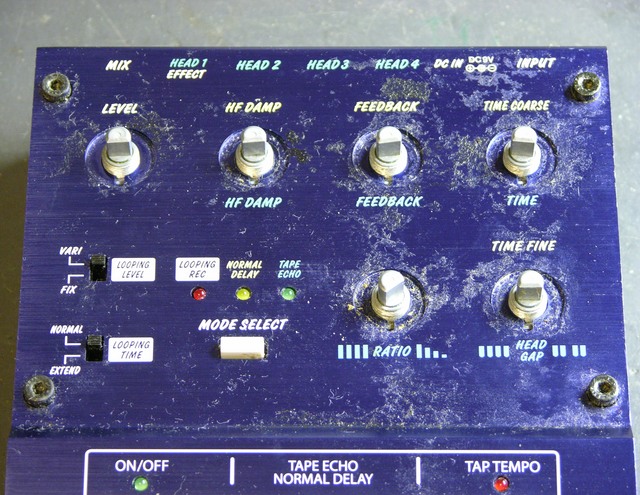
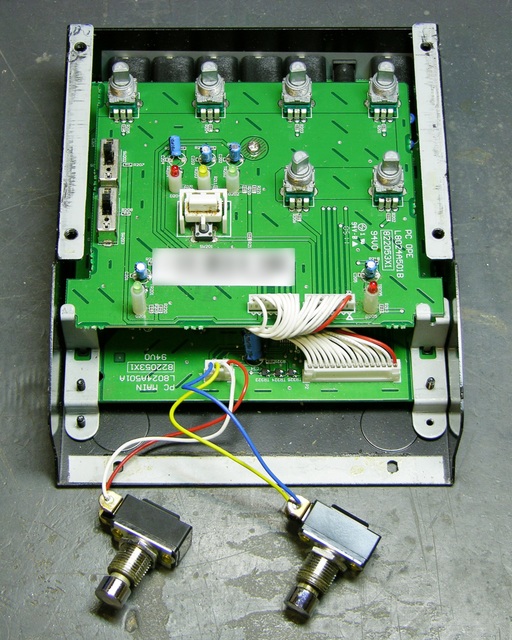
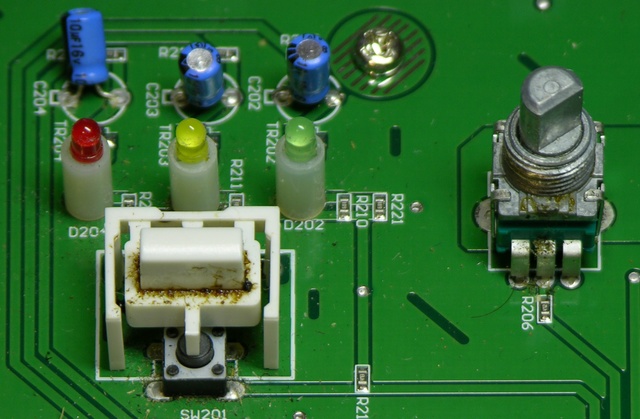

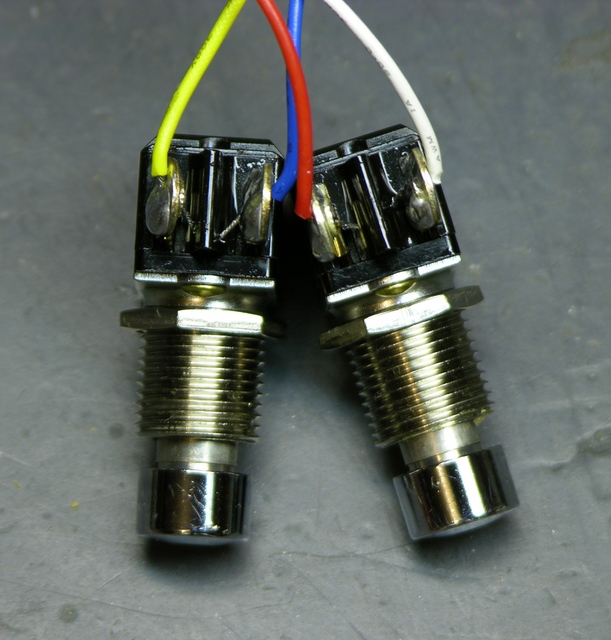
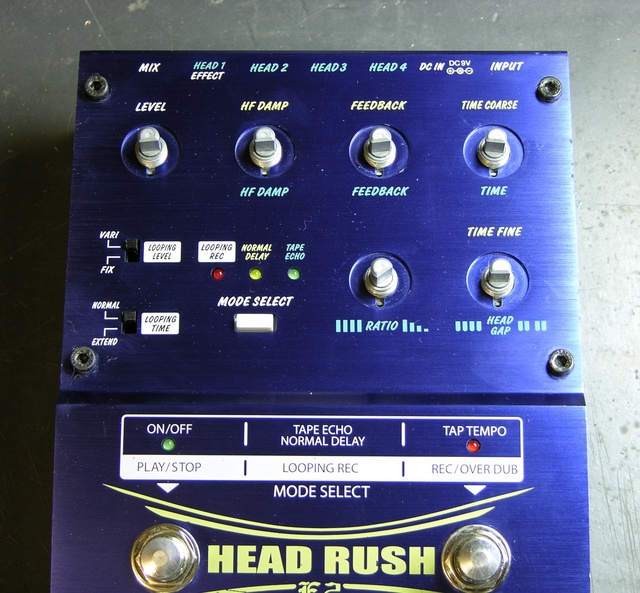
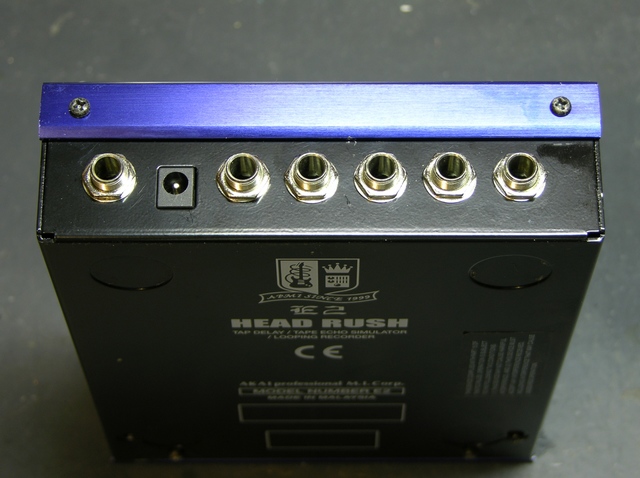
I am just after buying the head rush e2 akai but the instructions are impossible to follow not enough information and examples on how to use any where on the internet with more detailed instructions on how to use the Head Rush by Akai .
Thank You ..
Hi Keith, great blog! I’m looking at rackmounting a loop pedal and operating it from a passive switch similar to a FS-6 ( http://www.rolandus.com/products/productdetails.php?ProductId=686&ParentId=52 )
Would this be possible with the headrush, i currently own a digitech jam man however the headrush insides look like they may be a little easier to work with.
Any help would be greatly appreciated.
Cheers Joel
Joel, some thoughts –
I think it’d be easy to replace (or better, supplement) the Headrush’s panel switches with external switches. I’d need to reopen mine and double-check the wiring — I assume they have a common pin like the FS-6 pedal (even though they don’t share a wire), but I’d check.
How did you have in mind rackmounting it? Put it on a rack shelf, or actually put rackmount ears on it?
Do you know that the Headrush only has about 18 seconds of loop time? I understand the JamMan has a lot more recording time than that.
Do you want to do the rewiring yourself? Do you want to keep the JamMan once you have the Headrush? Depending on exactly what you’re after, I could be interested in providing you a modified Headrush (with original switches still intact and a jack discreetly added for the FS-6) in exchange for a JamMan, which would make an interesting addition to my collection as well as a great story about how I acquired it.
My basic setup is a line 6 podxt live and digitech jam man. However i just got in ears and am in the process of switching to a full rackmount setup, i’ve got a mixer, a pod xt pro + shortboard, and now i’m just looking at rackmounting a loop pedal. I do use lengthy loops for a few songs so 18 secs might not be long enough, the jam man doesn’t have the same type of switches as the head rush however, and i really like the units features and loop quality. So basically ultimately i would like to rackmount the jam man and have a fs-6 type switch on the floor.
Thanks for the quick reply, any suggestions would be great.
Joel, I may just be dense, but if you’d like to use the JamMan with a floor switch, why not get the FS3X that appears to be made for it? Does it not have the right functionality, or is it outrageously expensive?
Haha no not dense, if it was that easy it would be awesome! But it only has the functionality of changing loops up and down, I was hoping to operate only the record/overdub and stop buttons from the switch as I keep all my looping live.
Joel, let me summarize so far:
If I’m on track, then have you opened the JamMan to look at what switches are underneath the stomp pedals? Are they just a different form factor on the outside but maybe still a plain old momentary contact switch on the inside; or are they really something different (optical, Hall effect, potentiometer) on the inside?
Excactly on track! The switches inside look like this sorry i haven’t taken the top off i’ve been looking for some info on switches online but haven’t had any luck….
http://i105.photobucket.com/albums/m223/joelwharrison/Photo4.jpg
Sorry about the dodgy pic i couldn’t get a decent one, however the switches look similar to this inside http://www.elitehackers.info/forums/showthread.php?t=18508
Joel –
The photo is clear enough; that’s a fairly common tactile switch. If you get closer, you should find that it has four leads, which are coming out of two ends of the square. If you get out a continuity meter and test it, you’ll find that the leads are internally wired in pairs, with the two leads of each pair facing each other across a distance (not sitting close to each other on the same side). It’s almost certainly a normally-open switch; so when you press the button, the side-by-side leads get connected to each other.
With more searching, I’m guessing you’ll find that the two switches have a pair of leads connected together, and that that pair of leads is also connected to ground — or possible a positive voltage supply. I’ll refer to this as common for now.
You should be able fairly easily to solder the tip of a wire onto any of the switch’s leads. If I were wanting to add remote switches to your JamMan, I’d carefully open it, find a place I could mount a stereo jack to accommodate the external footswitch, wire that jack’s pin that corresponds to the footswitch’s common to any lead that’s part of the common pair of your original two switches, and wire the jack’s two switch pins to the non-common pairs on the two switches.
You’ll then be able to use both the original footswitches and the new external ones — not a requirement, just a side effect of the easiest way to wire it. If it’s important that plugging in the external switches disable the original ones, you’ll need to do some surgery on the PC board that I’d be leery of trying to describe to you from a distance, but you may be able to figure out for yourself.
Good luck!
KEITH YOU ARE A LEGEND!!! I’ll have to buy a set of screwdrivers to actually open the shell, I’ll let you know how I go with it. Thank you for everything, I found diddly skwat on the net till I came across your blog!!
Hi Keith-
I found your site via google and it seems you’re my last hope. I have the e1 headrush and no one here in Paris where I live wants to help me repair my pedal. It has developed a very obvious ‘hiss’ (or white noise) and I can’t figure out how to fix it. There’s 1 place in all of Paris (and region-6 million!) that even takes pedals. The guy took it but gave it back and said he couldn’t get it not hiss. I brought it home, plugged directly into my powered monitor and hiss galore. I don’t want to buy the e2 if I can help. I can’t help having the feeling that my unit is basically good but there’s just one thing wrong that I can’t see or get to. I gig with this unit and it’s important to me. I don’t abuse it though. The problem started after i had been rehearsing in a very dry and dusty barn actually. I’ve opened it up it, taken it apart but nothing I see is obviously dangling or misconnected or… For some reason I’m thinking that not enough signal is getting to the ‘mix’ (or send) jack. It makes this noise though in all the various channel sends. Does any of this ring a bell with you about anything I could do? Should I just give up on this?
Booker
PS-
after a lot of surfing it really seems these units (both the E1 & E2) have hissing noise issues. At least that’s what people are writing in about. of course they probably sell thousands that are fine or people don’t notice but anyway… I use mine for acoustic guitar work (plugged via DI box into the house PA) and mine was absolutely silent until recently.
just thought you should know.
Booker
Booker, I don’t know what to tell you — I have no experience with the E1 and I’m not sure what would be causing the hiss, especially a sudden appearance of it. I suppose for good measure I’d change out the electrolytic capacitors, but it seems to me that hiss is more likely to be coming from a semiconductor.
Maybe another reader has a suggestion here.
Thanks for getting back to me Keith. I knew it was a long shot and probably impossible to diagnose over the web. Anyway, I’d been having some pretty good luck here lately with some other DIY projects of mine and I thought I’d give it a whirl.
I guess question: Would it be possible for some amature like myself to identify a bad semiconductor?
Hey- if I’m going down I’m going down swinging…
thanks for taking the time though…
best,
Booker
Booker, without a schematic, I don’t know that I’d be interested in tackling it myself, on one that I owned personally and had in front of me. I just wouldn’t know where to start. Also I suspect the E1 is built with surface-mount components (like the E2), some of which will be custom and unobtainable and all of which take a fair bit of experience and/or specialized equipment to replace.
I’m sorry to bear the bad news, but I think the tech you took it to was right about turning it away. Even with a schematic, the hourly rate for a tech to trace through and find the introduction of the hiss would probably cost more than a new unit.
Thanks Keith-
honesty is always better then dragging it out.
thanks for your advice and the site. Pretty cool and helpful info.
booker
Hi Keith Ive had a E2 for a year and the adaptor has just packed up. The box in the middel of the wires hums but no power seems to be getting to the pedal. I want to get a new adaptor but would rather not get an Akai one as they’re not very sturdy and cost a bomb, any suggestions.
All the best Joe
Joe, it’s a standard 9V power supply — any guitar effects power supply will do. I got a Visual Sound “1 SPOT” supply and a multi-plug cable to power the different effects I play with.
Cheers Keith, I’ll be Loop the loop again in no time.
All the best Joe
Hi,
I am a singer/songwriter with a headrush e2. The 14 page reference manual isn’t very detailed, and I have been scouring the internet to figure out if I need 2 amps to use the delay function, or if I can use just one amp? Can you please help me with this? Maybe this is a simple question, but I’m just entering the world of loopers and effects pedals. It would be greatly appreciated. Thank you!
Aliya
Aliya, the best way to learn about the HeadRush is to plug it in and try it!
That said, no, you don’t need two amps for the delay function. If you use only the MIX output, you get both your original signal and the delayed signal together in the one output. When you plug a second cable into the EFFECT output, only then do the original and delayed signals route to different outputs.
My recollection is that the HeadRush won’t work directly with a microphone-level signal. Even if it does, I think you’re going to be happiest running your mic into a mixer, then use the mixer’s effects loop to go to the HeadRush and back.
And depending on your mixer, you may need to use the HeadRush’s EFFECT output to return only the delayed signal to the mixer, if it “keeps” the original and mixes the effects return back into it (versus “discarding” the original and relying on the effects loop to return exactly what you want).
I hope this makes sense; and again, you’ll probably get the most out of it if you plug it in and start trying things to see what works for you. Good luck!
Thank you, thank you Keith!
Yup, I did plug it in last night for the first time and played with it, and its super fun. I appreciate you taking the time to respond.
I’ll mess around with it some more!
Aliya
Hi Keith,
As someone said earlier in this section, I also have a buzzing (E2) unit that I only really noticed when I hopped onstage! I pulled everything out of it (I run about 3 to 4 other pedals through it) and plugged the guitar straight into it and the buzz/high pitched noise was awful – not a great start to my gig.
The unit is only about 6 months old and I only ever use it in my bedroom. Friends have suggested earthing the DI unit (not sure what that means in a gig context!), battery running the unit (I’m not sure this is possible) or simply buying a new unit…
help!
One thing to watch about using a replacement power supply…you need more info than just “9 volts”. Check the original power supply, (or it might also have the same info on the pedal itself) Some power supplies put out AC current, others put out DC current. Make SURE your replacement power supply is the same as the original or you could damage your pedal. The same goes for polarity. Check to see if the barrel or the pin on the plug is positive (+) or Negative (-). Some devices will work either way, some won’t, but why take a chance? Wall wart power supplies are so cheap and easy to come by….. Also check the amperage of the supply. In this case it will be measured in milli-amps (mA) It is ok to have a higher mA value than the original, but don’t go much lower, or you may get poor, or no performance from your pedal.
Can anyone tell me how to use a battery with this rather than the power supply, is there a connector ect
You can’t really use a battery with it. The current draw is quite high, and would suck a 9V dry in a matter of minutes. You could simply wire the adapter plug to the terminals of a larger battery unit, but that becomes very impractical very quickly.
Mine got rained on once and ever since then the time control and feedback pots can’t be set to their minimum so the sound is pretty unusable overall. Plus, the switches are intermittent and the unit stops the loop when it feels like it. I’ve already had this thing sent to Akai once already. I’ll try your cleaner solution before sending it off for repair!
Also, chris, I actually tried wiring a 9v battery casing with a plug on it and the headrush unit worked or about 10 minutes before it totally drained the battery.
Funny note: Akai sells refurbed Headrush units on their website, aso you know there’s been a lot of these sent in for repair!!
Hey mine does the same thing, it stops the loop anytime it wants to, and also the switches doesnt respond how they were supoused to. eralier today i just ordered new switches, i hope that works, if not do you think its a way to repair the stock ones? thanks man
Dre.
Hey guys! Just a note that I fixed mine last night. I did 2 things, I sprayed contact cleaner into the pots and I also resoldered all the joints of the pots to the PCB. Plugged it in and it works like new!
I also sprayed the footswitches and the connector harness from the top PCB to the bottom PCB just for good measure. THANKS FOR THE TIP, you saved me a lot of money and headaches!!!
Everyone should try this first before buying new parts!!!
Oh, FYI, you can’t use any old 9v power supply. I tried using one I had found from a cordless phone and it made a hum. Too bad.
I’ve been researching for noise and hiss fixes for the HeadRush (E2) and came across your site. Must be a systemic problem for this unit. Any new fixes other than good cleaning?
What I was doing wrong was putting my amplifier (or in my case a Sunrise Tube interface- basically an amp) AFTER the Akai. By putting the amp first, the noise/hiss disappeared.
hope this helps.
I put the E2 as the last effect on my pedal board before the input to my amp, (Marshall Bluesbreaker). I don’t have an effects send. I eliminated the pedals one by one and the E2 was making the hiss. I know placement is important in the chain to stop noises. It’s funny, I have an old AD/A flanger and an old Vox wah I did the true by-pass mod to that are quite as a mouse. The Lovepedal Vibe and TC Tuner have clock noise. The TC tuner especially when in mute when I tune. The Marshall amp is where I get my overdrive. The amp is very responsive to picking hard or soft, I like it like that. Maybe there’s a quieter delay out there that can work with my rig.
Thanks for the response.
awesome, this guide fixed my Akai right up! Thanks
The foot switches are really unreliable. I have to press them really hard and even then sometimes nothing happens. Basically do I just take the case off and spray the inside of the switches with a contact cleaner? Really helpful guide, thanks!
Ethan, yup, that’s it! You’ll be amazed.
Has there ever been a snematic published for the E2?
Can you advise me about a replacement switch for akai headrush E2. I see it is a small PCB mount switch under a plastic push device. Is it a simple PCB switch non latching and changes mode through some sort of logic or is a special purpose device.
Any help would be greatly appreciated.
Thanks Fred
For the above I forgot to mention it,s the mode select switch I am referring to.
Akai headrush E2
Thanks Fred